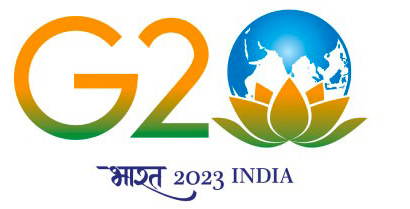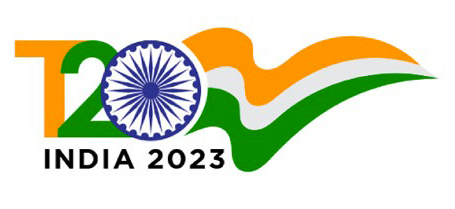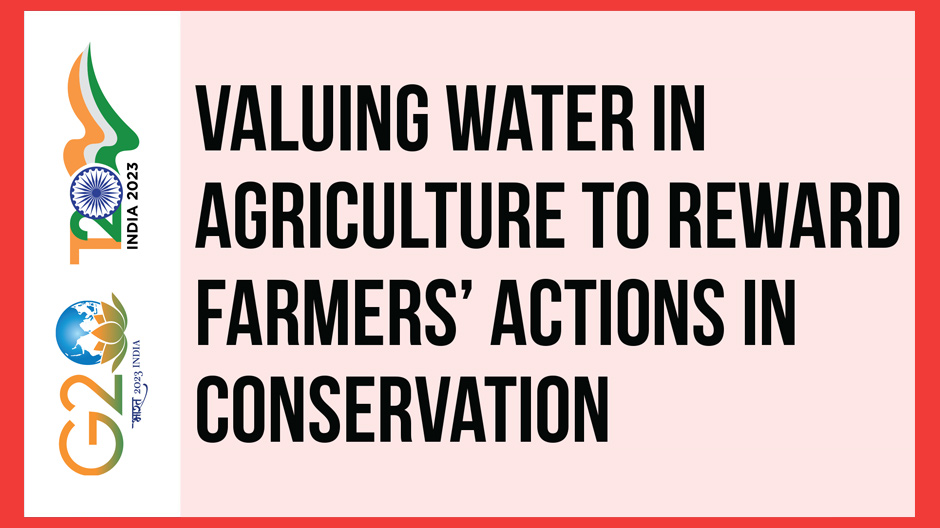Task Force 6: Accelerating SDGs: Exploring New Pathways to the 2030 Agenda
Efficient water use is of paramount importance in ensuring food security. Since 2017, when the G20 Agriculture Ministers’ Action Plan was adopted, there has been a clear acknowledgment of the challenges and risks associated with water security as well as the need to encourage sustainable water management in agriculture. Despite comprising the world’s largest economies, food insecurity remains a significant challenge in some G20 countries.
This Policy Brief advocates for the need to develop comprehensive water valuation methodologies in agriculture by adopting informed approaches on incorporating water availability in green and blue forms in agricultural production systems. It further recommends that the G20 countries should adopt frameworks to implement such approaches. Additionally, in order to recognise and incentivise farmers’ efforts towards water conservation, the G20 countries should adopt reward/compensation mechanisms for farmers based on the value of water through an agricultural water standard which supports the development of a credit system on the lines of the carbon credit scheme.
1. The Challenge
As water scarcity is aggravated by climate change impacts, inaction, and inefficient use of water, it will have severe costs that involve steeper trade-offs. Since the beginning of industrialisation, there has been a surge in greenhouse gas concentrations in the atmosphere. This has resulted in positive radiative forcing, which causes more energy from the sun to be retained and reflected to the Earth’s surface, thus intensifying overall temperatures and leading to global warming. Intergovernmental Panel on Climate Change (IPCC) reports (2007 and 2018) have projected a temperature increase of 1.8–4°C by 2100 in global latitudes, especially in seasonally dry and tropical regions.[1] Additionally, dryness and wetness are increasing in parts of the world that earlier saw moderate climates.
About 80 percent of the world’s cultivated land is rainfed and contributes to about 60 percent of global food production.[2] The remaining 20 percent, constituting about 275 million hectares, is irrigated and accounts for 40 percent of global food production.[3] Globally, irrigated agriculture is by far the main consumer of water, accounting for almost 70 percent of all freshwater withdrawals. Among the G20 countries, there is a clear divide between developed and developing economies in terms of agriculture water efficiencies. Agriculture accounts for about 44 percent of the total water withdrawals in the USA, France, and Australia, but in countries like Brazil, Russia, India, and China, it accounts for 70 percent on average; for instance, in China it is 60 percent and in India 80 percent.[4] In India, South Africa, and China, the number of rainy days during the season has decreased and rainfall intensities have increased, resulting in frequent occurrences of dry spells during the crop growth period.[5],[6]
The water cycle is a fundamental part of the climate system. Several effects of climate change manifest through the water cycle, such as changing precipitation patterns and increased intensity and frequency of floods and droughts.[7] By 2050, over half of the world’s population is projected to live in water-stressed regions and 1.6 billion people are projected to live with the risk of floods.[8] Climate change has triggered widespread shifts in the cryosphere (which includes snow, glaciers, permafrost, and lake and river ice) and is leading to a sharp reduction in global snow and ice cover. With glaciers melting faster, the amount and seasonality of runoffs in glacier-fed river basins have been impacted which, in turn, is affecting farming communities downstream.[9],[10] For example, in China, water issues are especially pronounced in the more arid, northern parts of the country, where the average water availability is 760 cubic metres per year—well below the internationally agreed threshold for water scarcity.[11] Similarly, environmental and socio-economic factors in South Africa’s agricultural system have been affected by droughts, creating cascading pressures on the nation’s agro-economic and water-supply systems.[12] These shifts will worsen water stress, which is a critical issue in the twenty-first century, especially in Asian and African nations.
Water scarcity pertains to blue water (surface and groundwater stored in lakes, reservoirs, aquifers, and rivers) scarcity; generally, green water (water from precipitation held in soil and available to plants) and grey water (untreated water from domestic, commercial, and industrial sources) are not taken into consideration (Figure 1). There is an urgent need to produce more with less water by enhancing water use efficiency. Innovations in this area are a necessity for sustainable water use in agriculture and for developing climate-resilient strategies to ensure food security as well as sustainable supply chains.
Figure 1: Green and Blue Water
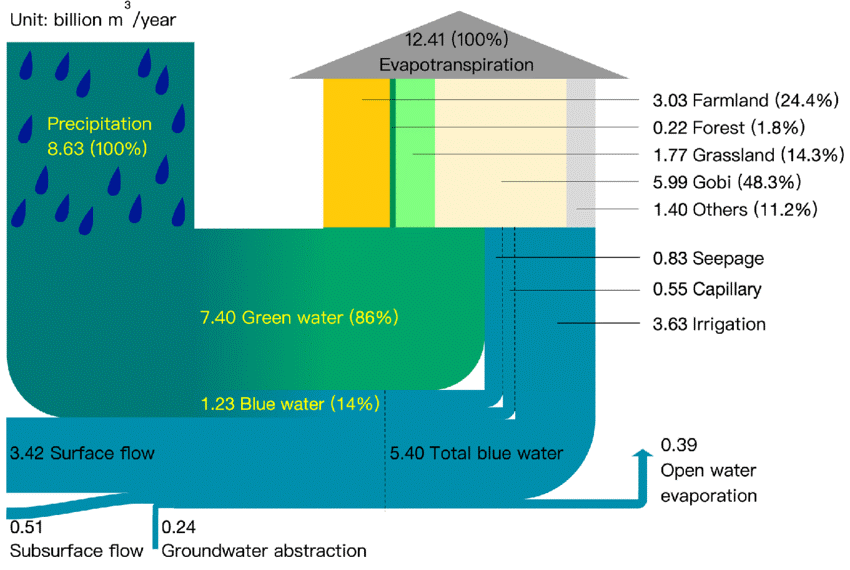
Source: Mao et al. (2020)[13]
As the global population rises, increased urbanisation, climate change, and a shift in food consumption are likely to dramatically increase demand for water. As per current trends, demand for water will exceed supply by 40 percent in 2030, forcing governments to spend US$200 billion per year on upstream water supply—up from historic averages of the last three decades from US$40 to US$45 billion.[21] According to projections from the World Economic Forum, by 2030, approximately 51 percent of the population in developing economies like India is expected to belong to the upper-middle and high-income brackets, placing them in the high-consuming category. This represents a significant increase compared to the 24 percent recorded in 2020.[22]
Food demand is driven by a combination of factors, including rising urbanisation, diminishing farm sizes, advancements in education, and a growing trend of people migrating to cities for improved livelihoods.[23] To meet this growing demand, agricultural production will have to increase manifold. Additionally, rising incomes and economic growth are expected to tilt food demand towards meat, fish, and dairy products, which will also increase the demand for feed production. This will further impact water availability, since the livestock industry is water-intensive.[24]
Agriculture is a major consumer of water globally (40–80 percent), but policies on demand-side management of water in the agriculture sector are largely missing and often not given importance. Globally, there are firm rules on water for industrial and domestic use, despite its total consumption being about 7–20 percent, whereas policies and rules on water use in the agriculture sector are largely absent. Thus, there is urgent need to formulate and implement suitable policies for efficient conservation and use of water in the agriculture sector.
Suggested drivers for valuing water
Most policymakers choose to influence farmers through incentives such as subsidies on power and other inputs, coupled with a lack of updated extensions, resulting in low water-use efficiency. This approach fails to consider the value of water and the identification of suitable drivers to arrive at this value.
The value of water needs to focus on raising awareness about the myriad of associations and uses of water, including for social and economic use as well as for sustaining natural systems and cultural values.[25] Not valuing water can lead to mismanagement, poor investment, externalities, and loss and failure, ultimately jeopardising sustainable development and the wellbeing of both present and future generations.[26] Water needs a commons-based approach which is inclusive and community-driven, ensuring sustainable management of the public good, instead of the extractor-pays approach, which has worked in a limited way and has involved groups that have minimum water usage (manufacturing and household). The bulk of the water is used in the agricultural space, where water is largely not valued.
Valuing water is important to achieve the necessary thrift in resource use, which can be accomplished by raising awareness and communicating the value behind the productor process involving water and providing incentives to farmers to use it sustainably. However, developing the value of water is not an easy process; diverse water uses and multiple contexts—often social and cultural—shape stakeholders’ perceptions around water. Valuing water is useful in decision making, contributing to value determination and offering a structured and transparent mechanism that supports an inclusive stakeholder water-resource management process.[27] The key to valuing water in agriculture involves understanding key drivers that define the value.
This Brief presents five key drivers (Figure 2) that can contribute to determining the value of water, which can serve as a basis for developing a reward system for farmers.
Figure 2: Various Value Drivers for Water
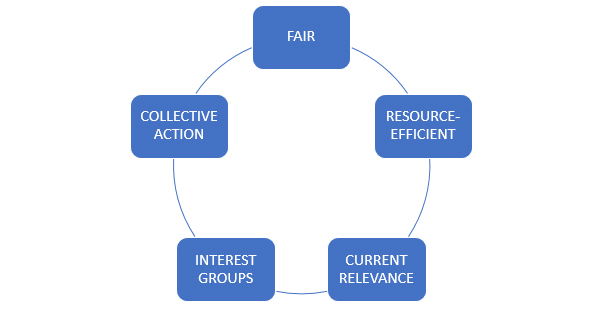
Source: Adapted from Solidaridad Asia Water Working Group Meeting (January 2023)
Fair: Fair use and allocation of water as well as fairness towards water as a resource. This driver further investigates equity in water sharing and prices across the agricultural value chain and how the price of water is determined and shared across the value chain. Fairness in agriculture is also determined by viewing smallholders as its primary users, as the bulk of food is produced by smallholders.
Resource-efficient: Water resource efficiency aids in assessing both demand- and supply-side efficiency. This is determined through crop-water efficiency, land-use efficiency, and energy efficiency. These values also need to be determined from the perspectives of livelihood and value-chain efficiency.[a]
Current relevance: Current water use has serious implications on the value of water. The main driver of global water scarcity in the last three decades has been increasing agricultural production with inefficient water management and population growth.[28] With rising income levels in developing countries, there has been a shift in diets as well increased global demand for livestock-based food products. This shift will accentuate the pressure on water resources. Increased water withdrawals result in decreased streamflow, which can have negative effects on hydropower generation, public water supply, and riverine ecology, which have the potential to aggravate upstream-downstream or transboundary conflicts.
Interest groups: The value of water in its competing uses needs to be identified so that decision-makers can better understand and communicate values and trade-offs between different uses.[29] The wide variety of water uses and contexts shape stakeholders’ attitudes, which are often influenced by social and cultural values and assumptions.
Collective action: Collective action through stakeholder-oriented approaches will provide a structured and transparent mechanism through which those affected by extreme water scarcity at all levels in a watershed area can express the value they ascribe to water-related goods and services by adopting a framework of shared risk, shared responsibility, and shared benefits.[30] This enables a collaborative resolution of issues which may otherwise jeopardise businesses, society, governments, and ecosystems. By working together, stakeholders can foster a shared understanding, devise comprehensive strategies, and find viable solutions to water-related challenges. These approaches can be used for conflict resolution, decision-making, informing stakeholders, supporting communication, and sharing insights.
2. The G20’s Role
The G20 nations collectively represent two-thirds of world population and 85 percent of global trade and thus, play a significant role in addressing global water challenges. Agriculture-dominant governments under the G20 facilitate approaches that motivate farmers to adopt water-saving practices, including reward mechanisms based on the valuation of water use such as financial incentives, subsidies, or grants for the adoption of efficient irrigation technologies (drip and sprinkler systems and water storage) and implementing soil and water conservation measures (mulching, crop diversity, farm management, bio fertilisers, compost use, etc.).
Collaboration between public and private entities is crucial for the successful implementation of reward mechanisms and the integration of water management practices into agricultural value chains. As a powerful and influential collective, the G20 is well positioned to provide preferential access to markets or premium prices for agricultural products produced through sustainable water management practices based on a water standard and valuation tool.
The G20 as a multilateral platform must take the lead in fostering the development of new frameworks for partnerships between farmers, agribusinesses, research institutions, and government agencies. These partnerships can facilitate knowledge sharing, technological innovation, and financial incentives for farmers who adopt water-saving practices, creating a conducive environment for sustainable water management.
Governments must be encouraged to share best practices and lessons learned regarding green water optimisation and blue water conservation in agriculture.[b] This can be facilitated through platforms such as the G20 and international organisations focused on agricultural development. Governments should prioritise adaptive measures to ensure long-term sustainability of water resources. This includes monitoring and managing the agricultural demand of water, implementing climate-resilient infrastructure, and supporting communities in developing water-security plans. Collaborative initiatives between countries sharing river systems can facilitate adaptive governance and sustainable water management.
By exchanging knowledge, success stories, and challenges, the G20 countries can learn from each other’s experiences and accelerate the adoption of sustainable water management practices in agriculture. Multilateral frameworks like the G20 should be leveraged to achieve the 2030 agenda for sustainable development, particularly to help water-scarce member nations—which are also largely agrarian countries—achieve the goals under SDG 6 and SDG 12.
3. Recommendations to the G20
- Reward farmers directly by developing agricultural water use standards and credits schemes: Develop a framework to incentivise farmers to adopt sustainable farming practices that lead to resilient water- and carbon-efficient agricultural production systems. The G20 countries can develop and adopt standards or certifications which deliver co-benefits, with inbuilt compensation mechanisms such as a ratings system which provides farmers with access to finance in the form of premiums or credits. Such a system must aim to make agriculture a competitive sector for the purchase of water, carbon, and other ecosystem service credits.
- Promote collaboration with supply chains (domestic and global) to nurture private investment in water-conserving agricultural technologies as well as sustainable farming practices in supply chains (e.g., cotton, sugarcane, rice): Adopt collaborative mechanisms within the G20 framework, where governments engage with global food and agriculture businesses to improve the sustainability, resilience, and climate impact of global food supply chains. Most global supply chain–based companies have clear frameworks and commitments to responsible business, but the adoption of due diligence strategies is often impacted by external pressures.[31] There are gaps in how companies translate policy commitments into implementation actions. The dynamic challenges of water management require closer collaboration with key stakeholders. A coordinated and sustainable supply chain initiative can drive leading food and agriculture companies from the G20 countries to invest in the sustainable sourcing of agricultural raw material, which will improve the environmental, social, and nutritional impact of their operations and supply chains.
- Place water management, particularly green water management, at the centre of agricultural policies and current schemes on subsidies to maximise harvest and facilitate the efficient use of green water to reduce the use of blue water: Reprioritise current incentives, premiums, monetary payments, and subsidies and schemes in the G20 nations towards green water management, which can fundamentally achieve two significant shifts in soil management—increasing the infiltration of rainfall into soil, thus reducing surface runoff; and putting unproductive evaporation to productive water use.
These shifts will help farmers harness rainwater efficiently which, in turn, will lead to a significant increase in water productivity (yield and biomass), reduce floods, prevent drought, and create more secure rural livelihoods.
Attribution: Prashant Pastore et al., “Valuing Water in Agriculture to Reward Farmers’ Actions in Conservation,” T20 Policy Brief, July 2023.
Endnotes
[a] Crop water use efficiency measures the amount of crop or pasture material produced per unit of water available to a plant, while agriculture land-use efficiency (more commonly known as productivity or yield) is determined as tonnes of a crop produced divided by the total number of hectares of land devoted to its production in any particular year (tonnes/ha/year). Energy efficiency improvements refer to a reduction in the consumption of energy for a given service (heating, cooling, lighting, etc.) or a level of activity like agriculture.
[b] Green water is that fraction of rainfall that infiltrates the soil and is available to plants. It includes soil water holding capacity and the continual replenishment of reserves by rainfall. Green water is the largest fresh water resource, the basis of rainfed agriculture and all life on land, and yet, it has received remarkably little attention in contrast to blue water—the fraction of water that reaches rivers directly as runoff or indirectly through deep drainage to groundwater and stream base flow.
[1] IPCC, “Summary for Policymakers,” in Global Warming of 1.5°C. An IPCC Special Report on the impacts of global warming of 1.5°C above pre-industrial levels and related global greenhouse gas emission pathways, in the context of strengthening the global response to the threat of climate change, sustainable development, and efforts to eradicate poverty, eds. Masson-Delmotte et al. (Cambridge: Cambridge University Press, 2018), 3-24.
[2] D. Molden et al., “Water Availability and its Use in Agriculture,” in Treatise on Water Science, ed. Peter Wilderer (Elsevier), 707-732.
[3] “446. Land and Water Resources for Food and Agriculture-Key Facts,” Japan International Research Center for Agricultural Sciences, December 23, 2021.
[4] OECD, “Water use and irrigation in agriculture” in Trends and Drivers of Agri-environmental Performance in OECD Countries (Paris: OECD Publishing, 2019).
[5] Chenxi Li et al., “Asymmetric response of short- and long-duration dry spells to warming during the warm-rain season over Eastern monsoon China,” Journal of Hydrology 603, no. C (2021).
[6] Wanjiru Thoithi et al., “Dry Spells, Wet Days, and Their Trends Across Southern Africa During the Summer Rainy Season,” Geophysical Research Letters 48, no. 5 (2021).
[7]Organisation for Economic Co-operation and Development, Financing a Water Secure Future (Paris: OECD, 2022).
[8]UNESCO World Water Assessment Programme, The United Nations world water development report 2018: nature-based solutions for water (Paris: UN, 2018).
[9] Wouter Buytaer et al., “Glacier Melt Content of Water Use in the Tropical Andes,” Environmental Research Letters 12, no. 11 (2017).
[10] Intergovernmental Panel on Climate Change, “High Mountain Areas” in The Ocean and Cryosphere in a Changing Climate: Special Report of the Intergovernmental Panel on Climate Change (Cambridge: Cambridge University Press, 2022), 131-202.
[11] Michael Gross, “China’s water challenges,” Current Biology 28, no. 4 (2018): R135–R138.
[12] Isabel Meza et al., “Drought risk for agricultural systems in South Africa: Drivers, spatial patterns, and implications for drought risk management,” Science of The Total Environment 799 (2021).
[13] Ganquan Mao et al, “Assessing the interlinkage of green and blue water in an arid catchment in Northwest China,” Environmental Geochemistry and Health 42 (2020): 933–953.
[14] Meredith Giordano et al., “Water Scarcity and Challenges for Smallholder Agriculture” in Sustainable Food and Agriculture, eds. Clayton Campanhola and Shivaji Pandey (Academic Press, 2019), 75-94.
[15] UNESCO World Water Assessment Programme, The United Nations world water development report 2020: water and climate change (Paris: UN, 2020).
[16] Mesfin M. Mekonnen, and Arjen Y. Hoekstra, “Four billion people facing severe water scarcity,” Science Advances 2, no. 2 (2016).
[17] Giordano et al., “Water Scarcity and Challenges,” 80.
[18] UNESCO World Water Assessment Programme, The United Nations world water development report 2021: valuing water (Paris: UN, 2021).
[19] N. Fitton et al., “The vulnerabilities of agricultural land and food production to future water scarcity,” Global Environmental Change 58 (2019).
[20] UNESCO World Water Assessment Programme, The United Nations World Water Development Report 2023: partnerships and cooperation for water (Paris: UN, 2023).
[21] UN Environment Programme, Options for Decoupling Economic Growth from Water Use and Water Pollution: A report of the Water Working Group of the International Resource Panel (Paris: UN, 2016).
[22] World Economic Forum, Future of Consumption in Fast-Growth Consumer Markets: India (Geneva: WEF, 2019).
[23] Jim Woodhill et al., “Food systems and rural wellbeing: challenges and opportunities,” Food Security 14 (2022): 1099–1121.
[24] Food and Agriculture Organization of the United Nations, Water for Sustainable Food and Agriculture: A report produced for the G20 Presidency of Germany (Rome: FAO, 2017).
[25] Global Water Partnership, Valuing Water: A Conceptual Framework for Making Better Decisions Impacting Water, 2020.
[26] James Dalton, “Why are we valuing water?,” IUCN, March 26, 2021.
[27] Petra Hellegers and Gerardo van Halsema, “Weighing economic values against societal needs: questioning the roles of valuing water in practice,” Water Policy 21, no. 3 (2019): 514–525.
[28] Haidi Heidari et al., “Vulnerability to Water Shortage Under Current and Future Water Supply-Demand Conditions Across U.S. River Basins,” Earth’s Future 9, no. 10 (2021).
[29] The Australian Water Partnership, Valuing Water: A Framing Paper for the High-Level Panel on Water (Canberra: AWP, 2016).
[30] CEO Water Mandate. “Understanding Collective Action.” CEO Water Mandate. Accessed June 20, 2023.
[31] OECD and FAO, OECD-FAO Guidance for Responsible Agricultural Supply Chains,(Paris: OECD Publishing, 2016).
